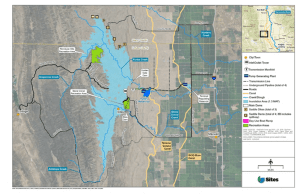This past month, California Governor Gavin Newsom announced the release of the California Water Supply Strategy: Adapting to a Hotter, Drier Future. In making the announcement, the Governor also committed an additional $2.8 billion in drought relief, water conservation, environmental protection for fish and wildlife, and long-term projects to permanently strengthen drought resilience.
Sounds good right? Not so fast. The plan lacked sufficient detail on how it gets done, and then includes four pages on the state’s desire to “modernize” the water rights system. While it doesn’t specifically say they are going to take away anyone’s existing water rights, comments in the strategy that discuss “making improvements to the water rights system to align with current public values and needs” cause many water rights holders plenty of concern.
For now, let’s take a closer look at the plan itself. Of the utmost interest is the proposed investment in water supply. While specific project details were somewhat lacking, the Governor’s strategy included:
1) Creating an additional four million acre-feet of water storage space to capture water in wet years, that would be achieved by the following:
- Expand average annual groundwater recharge by 500,000 acre-feet
- Complete the seven Proposition 1-supported projects and consider funding additional viable surface storage projects
- Expand San Luis Reservoir by 135,000 acre-feet
- Rehabilitate dams to regain storage capacity
- Support local stormwater capture projects to increase annual supply capacity by 250,000 acre-feet by 2030 and 500,000 acre-feet by 2040
2) Recycle and reuse at least 800,000 acre-feet of water per year by 2030, and 1.8 million acre-feet by 2040, by implementing the following:
- Reduce annual water demand in towns and cities by 500,000 acre-feet by 2030
- Fully implement SGMA to reduce agricultural groundwater pumping
3) Free up to 500,000 acre-feet of water per year by permanently eliminating water waste and increasing water use efficiency.
4) Make new water available for use by capturing stormwater, desalinating ocean water and salty water in groundwater basins:
- Increase stormwater capture by 250,000 acre-feet in 2030 and 500,000 acre-feet by 2040
- Increase desalinization by 44,000 acre-feet in 2030 and 84,000 acre-feet by 2040
That appears encouraging, but actual implementation is the key. Ultimately, we will have to wait and see the outcome. With regards to the water recycling projects, the state is estimating a cost of $15,000 per acre-foot, meaning the federal, state and local government would need to find approximately $10 billion windfall to achieve the 2030 goals and an additional $27 billion to hit the 2040 goal. Not an easy task.
On the desalination front, there are 14 seawater desalination plants currently operating at one level or another producing roughly 89,000 acre-feet of water per year, and an additional 23 brackish groundwater desalination plants that have a capacity of approximately 139,999 acre-feet. Unfortunately, many of these plants have faced huge permitting challenges along with opposition from environmental groups. A strong and robust policy will be needed here to make any meaningful headway.

Current and Proposed Projects
Groundwater recharge is the current buzzword in the California water world. But what can it actually do? The latest numbers from the state show they have invested nearly $350 million in local assistance for groundwater recharge projects. Local agencies have approximately 340 groundwater recharge projects on the books that could result in as much as 2.2 million acre-feet of additional water in wet years by 2030.
Completing aboveground water storage projects started under Proposition 1 could be significant. The current approved seven projects could add 2.77 million acre-feet. Permitting challenges lie ahead, and it will be interesting to see how quickly the state can help these projects traverse the gauntlet of opposition they will undoubtedly receive. Nonetheless, aboveground water storage projects have not been built in California since the late 70s and are sorely needed.
The project that seems to be getting a lot of support is Sites Reservoir, which is an off-stream storage facility intended to store water in wet years for use in the dry ones. Strengthening funding and support for this project to get through permitting and built is extremely important. Another project of particular interest is raising San Luis Reservoir by 135,000 acre-feet. This is a critical project at a very critical water storage facility and could go a long way in helping the state.
Other projects include creating stormwater capture projects in cities and reducing demand through increasing conservation programs and transitioning landscapes at homes and businesses. These efforts are smaller and tougher to accomplish; only time will demonstrate their success.
“Modernizing the Water Rights System”
In the last part of the plan, it discusses “modernizing the water rights system”, which can mean a lot of things, most of which are very concerning. Certainly, drought and the implementation of SGMA have changed the landscape of California but changing “water rights” is a whole other challenge. The plan itself calls for “modernizing water rights administration for equity, access, flexibility and transparency.” That is a very scary statement to some who believe this somehow means a “redistribution of water rights” in California. Current water rights holders should be concerned, especially when the document later states “improvements are a necessary predicate to modernize our water rights system in a manner that respects water rights priorities and aligns with current public values and needs.”
The plan was necessary given the state of the water supply situation in the state and the implementation of SGMA now fully underway. However, as is always the case in California, the “devil is in the details.” This is an issue that begs all Californians to be engaged in and to monitor very closely. Make no mistake, your future, and that of every Californian, is at stake here.

Roger A. Isom | President/CEO, Western Agricultural Processors Association
Roger is President/CEO of the California Cotton Ginners and Growers Association and Western Tree Nut Association. He brings over 30 years of regulatory and legislative advocacy experience, specializing in environmental and safety matters. Roger’s responsibilities include the management of both Associations’ staff and day-to-day operations. Roger is also the President of the Ag Energy Consumers Association (AECA), board member and Past President of the Ag One Foundation at California State University Fresno, and manages the Navel Orangeworm Action Committee (NOWAC).















